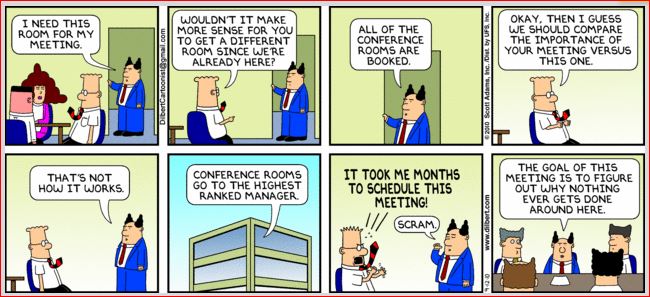Are Rampant and Unproductive Meetings Killing Your Company’s Bottom Line?
7 Tips to Decrease “Meeting Waste” 
Do you ever feel as though you’re on the meeting hamster wheel? Well, you’re not alone. According to a joint research study by Harvard Business School and the London School of Economics, executives typically spend more than 18 hours per week in meetings – that’s about a third of their work time.
Not only is the number of meetings being held increasing from past years, many meetings are deemed by participants as unnecessary and not productive at all. A 2012 Salary.com survey found that “too many meetings” was the #1 complaint as the biggest time-waster in the office, up from #3 in 2008.
Moreover, a report by the U.S. Bureau of Labor Statistics discovered that unnecessary meetings cost U.S. businesses approximately $37 billion each year. Most leaders don’t even know the cost of their meeting waste.
Meeting costs take into account the salaries of those involved adding in their benefits [healthcare, 401(k), etc.] in addition to meeting room, equipment and furniture costs. Then add the price for lost productivity and meeting costs can soar. A one hour meeting with six high-level attendees could easily cost upwards of $2,000. If you’d like to check your company’s meeting cost, there’s a great meeting-time calculator available that shows the cost of every minute that goes by in your meeting (http://www.bringtim.com/meeting-cost-calculator.html).
On the plus side, meetings serve many purposes including keeping staff informed, understanding client’s goals more clearly as well as facilitating collaboration and problem-solving. You shouldn’t declare a moratorium on meetings, but you should encourage your staff to take some necessary steps to ensure that their meetings are efficient and productive:
- Ask yourself, “Is a meeting really necessary?” – Oftentimes, people are on auto pilot that defaults to mindlessly scheduling a meeting. Determine what you need to accomplish and assess if there are more effective ways to communicate or collaborate such as face-to-face meetings or group emails.
- Invite only the necessary participants – During my agency life, it wasn’t unusual to have more than eight people in a meetings, sometimes 3 people from one department. I realize that sometimes office politics and egos prevent us from limiting invitees, but whenever possible, make sure there isn’t redundancy on your list.
- Be prepared – Don’t be that annoying colleague who pulls together a rushed meeting just because she had a call five minutes ago with a client who only asked a hypothetical question. This will happen, but a meeting is more effective when you are able to provide the answers to anticipated questions from participants.
- Create an agenda – Meetings do run much more smoothly when participants are informed of the sequence of discussion topics. Having an agenda also helps reign in everyone when a topic goes off tangent. Additionally, it lends more credibility to the meeting organizer who is perceived as being on the ball and efficient.
- Be the master of your meeting – As the organizer, you need to take the reins and facilitate the meeting with aplomb. Be in control of your meeting so that you keep the group on task and on time. If a key person is late, I don’t like to waste everyone else’s precious time waiting 15 minutes for one continuously tardy peer. Let everyone have a turn at speaking and be respectful of participants’ time – watch the clock and don’t go over the meeting’s scheduled time.
- Always end the meeting with action steps – The takeaway from the meeting should be a consensus on project direction as well as making sure everyone understands their roles and applicable next steps. You can also plan your next meeting while you have everyone in the room.
- Write a meeting recap – I know it seems like more work and a bit of overkill, but it truly saves you time and money in the long run when you provide a quick email recap as to what occurred in the meeting and lay out the next steps and roles of everyone who attended. This helps eliminate misunderstandings and is beneficial for an attendee who had to pull out of the meeting at the last minute.
Getting in the habit of enlisting your staff to follow these steps before sending out that meeting invite will help you whittle down the financial drain of meetings, and more importantly, help to ensure that meetings are run efficiently and effectively in order to achieve the goal(s) at hand.
